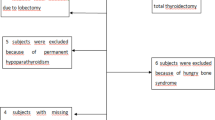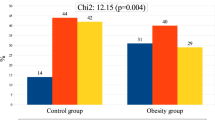Abstract
Objective:
To examine vitamin D status and parathyroid function in normal Danish women postpartum.
Design:
Three cross-sectional measures during follow-up of 89 women postpartum.
Subjects and intervention:
We assessed vitamin D status by measuring plasma 25-hydroxyvitamin D (P-25OHD) and the degree of secondary hyperparathyroidism by measuring plasma parathyroid hormone (P-PTH) in 89 Caucasian women at three consecutive visits: (mean (range)) 23 (10–37) days (spring), 117 (95–140) days (late summer) and 274 (254–323) days (winter) postpartum.
Results:
P-25OHD showed seasonal variations with higher values in late summer than in the other periods (P<0.001). At the first visit, 65% received vitamin D supplements. At the following visits, almost 50% were supplemented. Vitamin D insufficiency (P-25OHD<50 nmol/l) occurred more often during winter (28%) than in spring (14%) (Fisher's exact test, P=0.02) or late summer (7%) (P=0.0001). Irrespective of season, vitamin D insufficiency occurred most frequent in women who did not take vitamin D supplements (Fisher's exact test, P<0.02). Frank vitamin D deficiency (P-25OHD<25 nmol/l) was observed during winter in 6%. At all three periods, P-25OHD correlated inversely with P-PTH indicating secondary hyperparathyroidism at deficient vitamin D status. During spring, late summer and winter three, one and four females, respectively, had elevated plasma PTH.
Conclusion:
Vitamin D insufficiency with secondary hyperparathyroidism is a frequent finding in healthy Danish women postpartum and especially during winter. Vitamin D supplements reduced the risk of vitamin D insufficiency, especially during winter. Our results support the importance of increased alertness regarding information of pregnant and lactating women about vitamin D supplements. Furthermore, it has to be studied whether the present recommendations of an intake of 5–10 μg vitamin D/day are sufficient, especially during winter months.
This is a preview of subscription content, access via your institution
Access options
Subscribe to this journal
Receive 12 print issues and online access
$259.00 per year
only $21.58 per issue
Buy this article
- Purchase on Springer Link
- Instant access to full article PDF
Prices may be subject to local taxes which are calculated during checkout



Similar content being viewed by others
References
Affinito P, Tommaselli GA, di Carlo C, Guida F, Nappi C (1996). Changes in bone mineral density and calcium metabolism in breastfeeding women: a one year follow-up study. J Clin Endocrinol Metab 81, 2314–2318.
Arbejdsgruppe under Fagligt Forum for Amtssundhedsplejersker FffA (2003). Ammeundersøgelse år 2000–2002.
Brot C, Vestergaard P, Kolthoff N, Gram J, Hermann AP, Sorensen OH (2001). Vitamin D status and its adequacy in healthy Danish perimenopausal women: relationships to dietary intake, sun exposure and serum parathyroid hormone. Br J Nutr 86, S97–S103.
Cantorna MT (2000). Vitamin D and autoimmunity: is vitamin D status an environmental factor affecting autoimmune disease prevalence? Proc Soc Exp Biol Med 223, 230–233.
Cross NA, Hillman LS, Allen SH, Krause GF (1995). Changes in bone mineral density and markers of bone remodeling during lactation and postweaning in women consuming high amounts of calcium. J Bone Miner Res 10, 1312–1320.
Dawson-Hughes B, Dallal GE, Krall EA, Harris S, Sokoll LJ, Falconer G (1991). Effect of vitamin D supplementation on wintertime and overall bone loss in healthy postmenopausal women. Ann Intern Med 115, 505–512.
Dobnig H, Kainer F, Stepan V, Winter R, Lipp R, Schaffer M et al. (1995). Elevated parathyroid hormone-related peptide levels after human gestation: relationship to changes in bone and mineral metabolism. J Clin Endocrinol Metab 80, 3699–3707.
Glerup H, Rytter L, Mortensen L, Nathan E (2004). Vitamin D deficiency among immigrant children in Denmark. Eur J Pediatr 163, 272–273.
Greer FR, Searcy JE, Levin RS, Steichen JJ, Steichen-Asche PS, Tsang RC (1982). Bone mineral content and serum 25-hydroxyvitamin D concentrations in breast-fed infants with and without supplemental vitamin D: one-year follow-up. J Pediatr 100, 919–922.
Heaney RP, Davies KM, Chen TC, Holick MF, Barger-Lux MJ (2003). Human serum 25-hydroxycholecalciferol response to extended oral dosing with cholecalciferol. Am J Clin Nutr 77, 204–210.
Hegaard HK, Kjaergaard H, Moller LF, Wachmann H, Ottesen BS (2004). The prevalence of passive smoking among pregnant women in Denmark on their first visit to the midwife. Ugeskr Laeger 166, 3706–3711.
Hermann AP, Thomsen J, Vestergaard P, Mosekilde L, Charles P (1999). Assessment of calcium intake. A quick method comparerd to a 7 days food diary. Calcif Tissue Int 64, S82.
Holick M (1999). Vitamin D: photobiology, metabolism; mechanism of action, and clinical applications. In: Favus MJ, Christakos S, Goldring SR, Holick MF (eds). Primer on the metabolic bone diseases and disorders of mineral metabolism. An official publication of the American Society for Bone and Mineral Research, Kelseyville, CA: Lippincott Williams and Wilkins, 4, 92–98.
Hollis BW, Wagner CL (2004a). Assessment of dietary vitamin D requirements during pregnancy and lactation. Am J Clin Nutr 79, 717–726.
Hollis BW, Wagner CL (2004b). Vitamin D requirements during lactation: high-dose maternal supplementation as therapy to prevent hypovitaminosis D for both the mother and the nursing infant. Am J Clin Nutr 80, 1752S–1758S.
Jesudason D, Need AG, Horowitz M, O’Loughlin PD, Morris HA, Nordin BE (2002). Relationship between serum 25-hydroxyvitamin D and bone resorption markers in vitamin D insufficiency. Bone 31, 626–630.
Kalkwarf HJ, Specker BL, Bianchi DC, Ranz J, Ho M (1997). The effect of calcium supplementation on bone density during lactation and after weaning. N Engl J Med 337, 523–528.
Lips P (2001). Vitamin D deficiency and secondary hyperparathyroidism in the elderly: consequences for bone loss and fractures and therapeutic implications. Endocr Rev 22, 477–501.
Mosekilde L (2005). Vitamin D and the elderly. Clin Endocrinol 62, 265–281.
Mosekilde L, Nielsen LR, Larsen ER, Moosgaard B, Heickendorff L (2005). Vitamin D deficiency. Definition and prevalence in Denmark. Ugeskr Laeger 167, 29–33.
Nordic Council of Minister C (2005). Nordic Nutrition Recommendations Integrating Nutrition and Physical Activity 4th edn. The Nordic Council of Minister. Copenhagen.
Paoletti AM, Orru M, Floris L, Guerriero S, Ajossa S, Romagnino S et al. (2003). Pattern of bone markers during pregnancy and their changes after delivery. Horm Res 59, 21–29.
Pawley N, Bishop NJ (2004). Prenatal and infant predictors of bone health: the influence of vitamin D. Am J Clin Nutr 80, 1748S–1751S.
Prentice A (2003). Micronutrients and the bone mineral content of the mother, fetus and newborn. J Nutr 133, 1693S–1699S.
Ramlau-Hansen C (2004). Et follow-up studie om amnings indflydelse på plasma-homocystein. Master Thesis, Aarhus University.
Rasmussen L, Hansen GL, Hansen E, Koch B, Mosekilde L, Mølgård C et al. (1998). Vitamin D: bør forsyningen i den danske befolkning bedres? 236. The Danish Veterinary and Food Administration. Publication number 246 (December 1998). Copenhagen.
Ritchie LD, Fung EB, Halloran BP, Turnlund JR, Van Loan MD, Cann CE et al. (1998). A longitudinal study of calcium homeostasis during human pregnancy and lactation and after resumption of menses. Am J Clin Nutr 67, 693–701.
Sowers M, Eyre D, Hollis BW, Randolph JF, Shapiro B, Jannausch ML et al. (1995). Biochemical markers of bone turnover in lactating and nonlactating postpartum women. J Clin Endocrinol Metab 80, 2210–2216.
Sowers M, Zhang D, Hollis BW, Shapiro B, Janney CA, Crutchfield M et al. (1998). Role of calciotrophic hormones in calcium mobilization of lactation. Am J Clin Nutr 67, 284–291.
Sowers MF, Hollis BW, Shapiro B, Randolph J, Janney CA, Zhang D et al. (1996). Elevated parathyroid hormone-related peptide associated with lactation and bone density loss. JAMA 276, 549–554.
Specker B (2004). Vitamin D requirements during pregnancy. Am J Clin Nutr 80, 1740S–1747S.
Vieth R, Chan PC, MacFarlane GD (2001). Efficacy and safety of vitamin D3 intake exceeding the lowest observed adverse effect level. Am J Clin Nutr 73, 288–294.
Vieth R, Ladak Y, Walfish PG (2003). Age-related changes in the 25-hydroxyvitamin D versus parathyroid hormone relationship suggest a different reason why older adults require more vitamin D. J Clin Endocrinol Metab 88, 185–191.
Zamora SA, Rizzoli R, Belli DC (2000). Long-term effect of early vitamin-D supplementation on bone mineral status in prematurely born infants. J Pediatr Gastroenterol Nutr 31, 94.
Acknowledgements
We appreciate the technical assistance of Lisbeth Flyvbjerg, Charlotte Beck Gylling, Tove Stenum and Helle Thøgersen. This study was supported by grants from The memorial award of Market gardener Ove William Buhl Olesen and spouse Mrs Edith Buhl Olesen; The Foundation of Managing director Jacob Madsen and wife Olga Madsen; The Foundation of Miss Carla Cornelia Storch Moeller to promote medical research and The Faculty of Health Sciences, University of Aarhus, BSc. Bjarke Moosgaard is thanked for supplying information on the average index of sun hours and UV exposure per month in Denmark.
Author information
Authors and Affiliations
Corresponding author
Additional information
Guarantor: UK Møller.
Contributors: UKM, CHR, LR, TBH and LM designed the study. UKM and CHR carried out the study. UKM performed the statistical calculations and analyses, wrote the original manuscript and edited all subsequent versions. LR, LM and TBH contributed to the interpretation of data and commented on the manuscript. All authors approved the final version of the manuscript.
Rights and permissions
About this article
Cite this article
Møller, U., Ramlau-Hansen, C., Rejnmark, L. et al. Postpartum vitamin D insufficiency and secondary hyperparathyroidism in healthy Danish women. Eur J Clin Nutr 60, 1214–1221 (2006). https://doi.org/10.1038/sj.ejcn.1602440
Received:
Revised:
Accepted:
Published:
Issue Date:
DOI: https://doi.org/10.1038/sj.ejcn.1602440
Keywords
This article is cited by
-
A Cross-Sectional Study of Postpartum Changes in Bone Status in Indian Mothers
The Journal of Obstetrics and Gynecology of India (2016)
-
Maternal and infant vitamin D status during the first 9 months of infant life—a cohort study
European Journal of Clinical Nutrition (2013)
-
Effects of 25OHD concentrations on chances of pregnancy and pregnancy outcomes: a cohort study in healthy Danish women
European Journal of Clinical Nutrition (2012)



